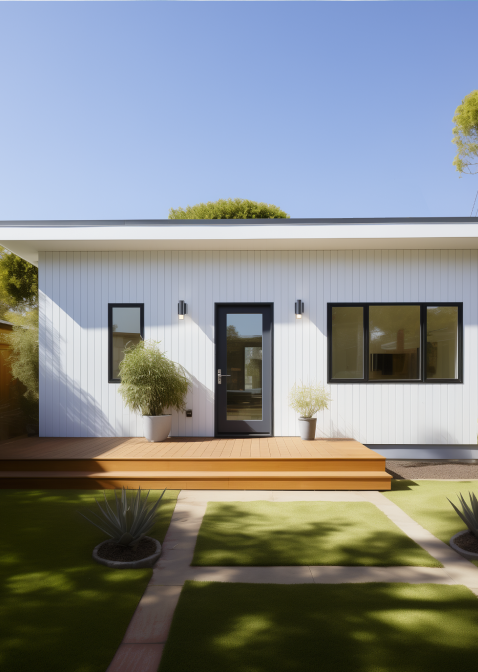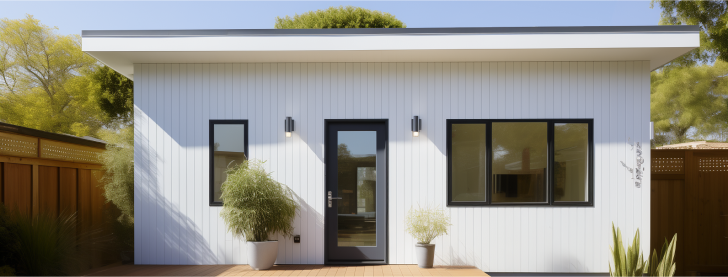An ADU is a small, separate living space that can be built on your property to provide additional housing. It provides the perfect solution for people in need of additional space. Before deciding to proceed with such a project, there are a lot of questions you’ll want to have answered.
This article will address some of the most frequently asked questions regarding ADUs to shed some clarity.
When deciding where to put an ADU, it’s crucial to think about things like the unit’s size and design, proximity to necessary services, and zoning and regulatory constraints. Make sure your lot is permitted for ADU construction under local zoning laws and development standards before you begin designing and constructing an ADU. No matter where you live, the steps you must take to find out the law will be essentially the same. Laws vary by location.
An ADU can be installed almost anywhere on your property, inside your main house, connected to it, or standing alone. Basements, attics, master bedrooms, and recreation rooms can all be transformed into accessory dwelling units. An alternative is to construct a new ADU and join it in the main house. It is possible to convert a detached structure, such as a carport, into an accessory dwelling unit.
From a practical standpoint, it may be preferable to build an ADU on the property line on the driveway side, which can provide privacy and isolation from neighboring homes while avoiding noise issues with connected properties close.
Customizing an ADU is determined by the individual’s demands and preferences. For those wishing to save time and money, pre-designed ADU plans can be a fantastic alternative, while others may prefer to customize their prefab ADU ideas.
However, keep these features in mind when customizing your new ADU:
Construction of an ADU can be financed in many different ways, including the following:
These financing options give homeowners who are thinking about adding an extra housing unit flexibility and a variety of options. You might choose one choice over the others depending on your financial condition, credit history, and the amount of equity you have in your property.
Making an informed choice regarding financing your ADU construction project can also be aided by speaking with a financial counselor or a real estate expert like our ADU Builders Bay Area team.
There are many different ways to construct an ADU, but the most popular one is to build it on a foundation. This strategy has numerous advantages over placing it on wheels or a trailer. In our opinion, foundations give our clients the finest results in terms of the stability and robustness of the construction.
The size of an ADU varies depending on the jurisdiction. ADU Builders Bay Area is dedicated to providing the most expansive selection of supplementary housing units available in the region. Our accessory dwelling units are thoughtfully crafted with safety and comfort in mind, with an emphasis on optimizing space and efficiency.
We know it’s crucial to construct ADUs with the highest possible standards of quality. That’s why we work so hard to deliver the largest ADUs on the market to our clients; more space for your family without sacrificing quality or security.
As we are dedicated to constructing ADUs of the appropriate size, you can rest assured that you will obtain a home that is both comfortable and efficient.
It’s worth noting that the zoning restrictions in a region and the size of the land both have a role in determining the maximum number of ADUs that can be built there. To find out how many ADUs can be installed on their land, homeowners need to go to municipal officials and a certified builder.
The potential for adding ADUs to a property is heavily influenced by the quantity and kind of existing buildings on the site. For instance, a multi-family building may only be allowed two detached ADUs, while a single-family home on a large lot may have room for two. Zoning and construction regulations in a given area may also impose limitations on the dimensions and layout of an auxiliary living unit.
Homeowners who are considering constructing an ADU should, in general, do their homework and talk to relevant authorities and professionals to ensure that their project is legal. Homeowners who build ADUs for their families or rent them out might benefit from the extra space and revenue they provide, but they must be careful to adhere to all applicable regulations.
Multiple accessory dwelling units are a great way to spread risk and boost earnings. Multiple ADUs may be permitted on land with an existing single-family home, depending on the area and zoning regulations. However, before constructing multiple ADUs, there are some considerations to keep in mind, including:
It’s smart to get advice from an expert like ADU Builders Bay Area on the zoning rules and best practices for your particular project before beginning construction on several ADUs. Researching the demand for and potential ROI of your ADUs is also recommended.
ADUs are similar in many ways and encounter similar design and development challenges. ADUs will normally have a bathroom, kitchen, and at least one bedroom, following the design criteria of ADU Builders Bay Area. An ADU typically has a considerably smaller façade than a typical house, however, it could have a bigger garage or parking space.
But many people are turning storage areas into extra bedrooms by converting them into off-street garages for vehicles or installing home offices on the main floor for employment opportunities—all without having to pay business or income property taxes. This results in significant tax savings over traditional homes in the majority of cities.
If you hire experienced specialists to build your ADU, you won’t have to put in a lot of mental or physical effort. ADU Builders Bay Area team would be more than pleased to assist you in making your vision a reality. Make an appointment at our office and we’ll provide you with a free estimate plan and sound guidance for your future home. Let us help you make the process quick, easy, and hassle-free.











